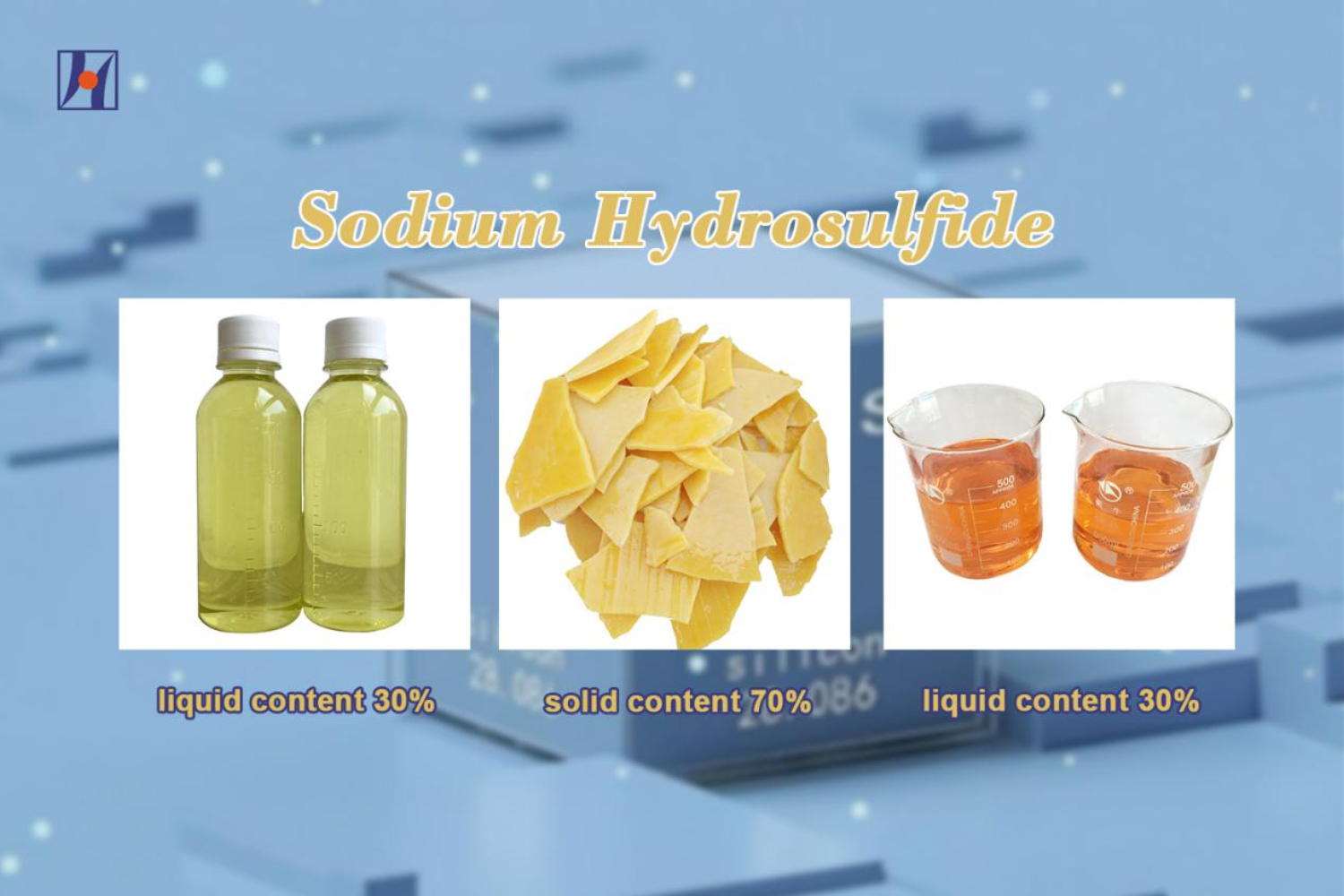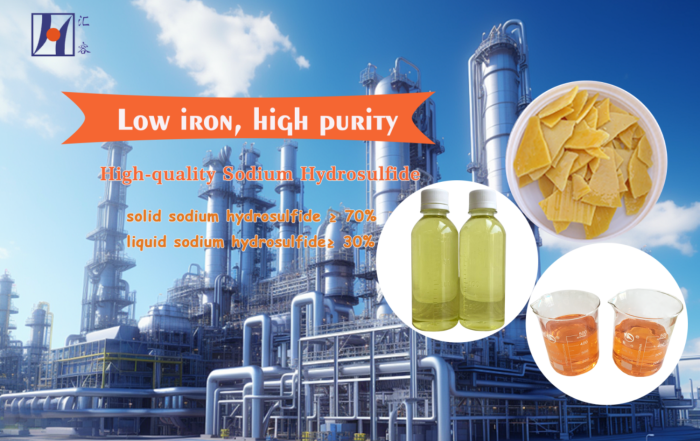Sodium hydrosulfide (NaHS) is commonly used in the pharmaceutical industry in solid form. Solid sodium hydrosulfide is easy to store, transport, and accurately weigh, which is crucial for dose control in drug synthesis reactions. When used, solid sodium hydrosulfide can be dissolved in an appropriate solvent (such as water or an organic solvent) according to specific reaction requirements to form a solution of the desired concentration.
1.Usage Methods
1.1 As a Pharmaceutical Synthesis Raw Material
Sodium hydrosulfide can be used to synthesize diuretics, analgesics, antibiotics, anticancer drugs, and other pharmaceuticals. In drug synthesis, it can participate in various chemical reactions to generate compounds with pharmacological activity.
1.2 Synthesis of Drug Intermediates
In the pharmaceutical industry, sodium hydrosulfide is often used as a raw material for the synthesis of drug intermediates, playing a vital role in the quality and efficacy of pharmaceuticals.
1.3 For Disease Treatment
Sodium hydrosulfide can be used for the treatment of infectious hepatitis, cirrhosis of the liver, and alcohol-induced diseases. In addition, hydrogen sulfide (H₂S) and its donor sodium hydrosulfide have anti-arrhythmic effects and can be used in the preparation of drugs to prevent or treat ventricular arrhythmias.
1.4 Preparation of Hydrogen Sulfide Donors
Sodium hydrosulfide dissolves in water to produce hydrogen sulfide (H₂S), which is recognized as a donor of H₂S. Hydrogen sulfide and its donor sodium hydrosulfide have new applications in the pharmaceutical field, such as in the preparation of anti-ventricular arrhythmia drugs and specific inhibitors of the Ito channel in cardiomyocytes.
1.5 Participation in Chemical Reactions
Sodium hydrosulfide is a strong reducing agent that can participate in various chemical reactions. For example, it can be used to reduce ketones, aldehydes, esters, and other compounds to promote chemical reactions. In organic synthesis, sodium hydrosulfide can be used to synthesize thiols and other divalent sulfur compounds and thio carbonyl derivatives.
2.Principles and Cases
2.1 Synthesis of Diuretics
Principle: In the synthesis of diuretics, sodium hydrosulfide can be used as a sulfur source to introduce sulfur atoms into drug molecules. For example, in the synthesis of some sulfur-containing diuretics, sodium hydrosulfide reacts with organic compounds to generate diuretic drug molecules.
Case: In the synthesis of mercapto benzimidazole diuretics, sodium hydrosulfide reacts with benzimidazole compounds to produce mercapto-containing diuretics. These drugs inhibit the reabsorption of sodium and chloride in the renal tubules, increase urine output, and thus exert a diuretic effect.
2.2 Synthesis of Analgesics
Principle: Sodium hydrosulfide can be used to prepare sulfur-containing analgesic drugs in the synthesis of analgesics. It can combine with aspirin and other drugs to form NO and H₂S dual-donor aspirin compounds, such as NOSH-1 to NOSH-4. These compounds have significant antitumor activity and can also exert analgesic effects.
Case: In the synthesis of NOSH-1, both NO donors and H₂S donors (sodium hydrosulfide) are combined with aspirin to form dual-donor aspirin compounds. In antitumor activity screening experiments, this compound can significantly inhibit the growth of various cancer cells and also has anti-inflammatory and neuroprotective effects.
2.3 Synthesis of Anticancer Substances
Principle: Sodium hydrosulfide can be used as a sulfur source in the synthesis of anticancer drugs to participate in the design and synthesis of drug molecules. It can combine with compounds that have anticancer activity to generate drug molecules that can inhibit cancer cell growth and induce cancer cell apoptosis.
Case: In the synthesis of a new type of sulfur-containing anticancer drug, sodium hydrosulfide reacts with specific organic compounds under certain conditions to produce drug molecules with anticancer activity. These drug molecules can block the cell cycle of cancer cells, inhibit the proliferation of cancer cells, and thus exert anticancer effects.
3.Extended Introduction
In the pharmaceutical industry, in addition to sodium hydrosulfide (NaHS), there are other sulfides that can be used as raw materials for pharmaceuticals:
3.1 Sodium Sulfide (Na₂S):
Usage: Sodium sulfide is commonly used for the synthesis of sulfur dyes, organic pharmaceuticals, and paper pulp. In the pharmaceutical field, it can be used as a sulfur source to participate in drug synthesis, such as for the preparation of certain sulfur-containing antibiotics and anticancer drugs.
Form of Use: It is usually used in solid form and can be formulated into solutions when needed.
3.2 Ammonium Sulfide ((NH₄)₂S):
Usage: Ammonium sulfide can be used to prepare certain sulfur-containing organic compounds, which can then be used to synthesize drugs.
Form of Use: It is typically used in solution form.
3.3 Zinc Sulfide (ZnS):
Usage: Zinc sulfide and cadmium sulfide are used to manufacture fluorescent powders, and high-purity cadmium sulfide is a good semiconductor. In the pharmaceutical field, they may be used in certain drugs or devices that require fluorescent labeling.
Form of Use: It is usually used in solid form.
4.Precautions
4.1 Personal Protection: Operators should wear personal protective equipment such as gas masks, goggles, rubber gloves, and protective work clothes to avoid contact of sodium hydrosulfide with the skin, eyes, and respiratory tract.
4.2 Operating Environment: Operations should be carried out in a well-ventilated area with closed operations and local exhaust to prevent sodium hydrosulfide from volatilizing or leaking into the air.
4.3 Storage Conditions: Store in a cool, dry, and well-ventilated warehouse, keep containers closed, and keep away from sources of ignition, heat, and incompatible materials such as oxidants and acids.
4.4 Waste Disposal: Waste containing sodium hydrosulfide should be disposed of in accordance with relevant regulations and should not be discharged directly into the environment.




